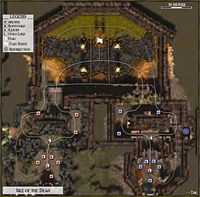Isle of the Dead
 This article is about the guild hall. For the quest, see Isle of the Dead (quest).
This article is about the guild hall. For the quest, see Isle of the Dead (quest).
| Isle of the Dead | |
|---|---|
| Region | Ascalon |
| Environment Effects | Tar |
| Map | |

| |
Isle of the Dead is reminiscent of the Catacombs from pre-Searing Ascalon, the Fissure Shore from the Fissure of Woe and the Labyrinth from the Underworld. This small guild hall is the smallest of all available guild halls.
Layout[edit]
Each base stands side by side with an exit through one of two paths to the east. From here an upper pathway between the two bases can be accessed or teams can proceed through a more open area covered in tar to the flagstand.
Map rewards and mechanics[edit]
- The central area around the flagstand is covered in tar which slows movement speed by 30%.
- In addition to these rules, this map follows the standard rules of a GvG.
Strategy and tactics[edit]
This hall does offer reasonable split options but the straightforward layout makes it difficult to outsplit other teams. One advantage lies in the location of the resurrection shrine will allow resurrected players to split immediately, unhindered by opponents in their lord room, but this is slim comfort in a situation where you are likely already losing. As both entrances to the base are very close together it can be very difficult to split out once a team starts pushing you back into your base when you start losing 8 versus 8, so decisions on tactics need to be made early.
Defensive team[edit]
Multiple paths lead to the front door, all of which are very poorly defended by isolated archers. The resurrection shrine is located a long way from the lord pit making it difficult to support base resurrecting party member while turtling. The inside of the base is relatively open with a few corners.
Offensive team[edit]
This map is a mirror image of the defensive team's base.
Disputed areas[edit]
The area around the flag stand is quite open except for four pillars, giving few opportunities for obstructing projectiles and choke points. The tar however can make it easier to bodyblock and stall incoming flaggers. The top paths provide a reasonable quick route for splitting but can be easily monitored from the flag stand.